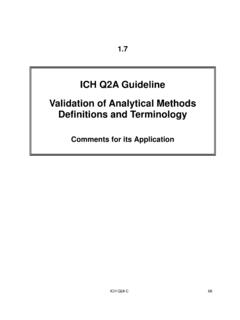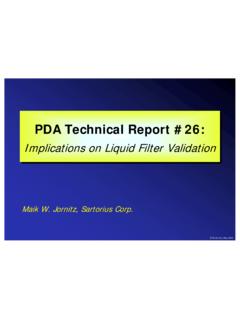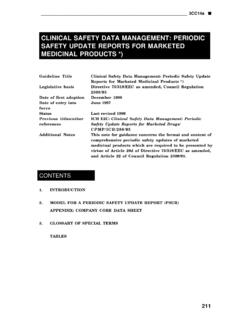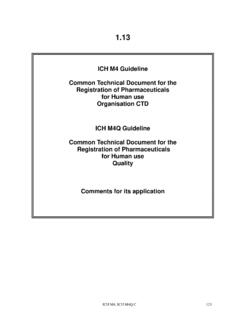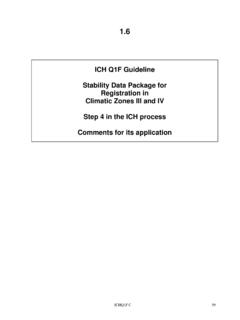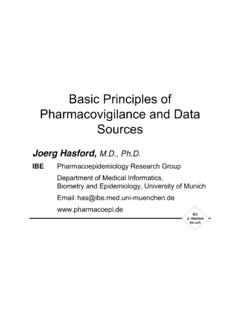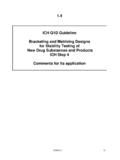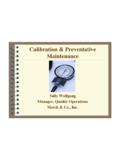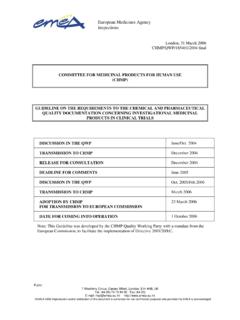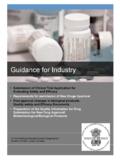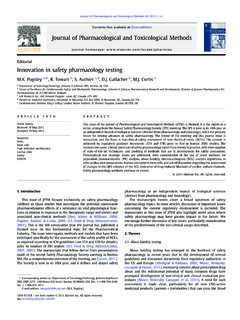Transcription of VALIDATION OF ANALYTICAL METHODS - IKEV
1 VALIDATION . OF. ANALYTICAL METHODS . INTERNATIONAL. INTERNATIONAL QUALITY. QUALITY SYSTEMS. SYSTEMS. 1. GERT BEUVING. INTERNATIONAL PHARMACEUTICAL OPERATIONS. INTERNATIONAL QUALITY SYSTEMS. TASKS: - Internal auditing - Auditing of suppliers and contract manufacturers - Preparing for and guiding of external inspections - Review of and advice on procedures & validations INTERNATIONAL. INTERNATIONAL QUALITY. QUALITY SYSTEMS. SYSTEMS. 2. General VALIDATION FDA-guidelines: VALIDATION is establishing documented evidence which provides a high degree of assurance that a specific process will consistently produce a product meeting its pre-determined specifications and quality attributes EU-guidelines Action of proving, in accordance with GMP-principles that any procedure, process, equipment, material, activity or system actually leads to the expected results INTERNATIONAL.
2 INTERNATIONAL QUALITY. QUALITY SYSTEMS. SYSTEMS. 3. General Conclusion: - Need for pre-determined operational & performance user requirements (URS) of process or system - Provide evidence of meeting pre-defined operational &. perfomance requirements - Provide evidence on consistency of meeting these requirements INTERNATIONAL. INTERNATIONAL QUALITY. QUALITY SYSTEMS. SYSTEMS. 4. General More specific: METHODS VALIDATION is the process of demonstrating that ANALYTICAL procedures are suitable for their intended use . (ICH Topic Q2B, March 1995). INTERNATIONAL. INTERNATIONAL QUALITY. QUALITY SYSTEMS. SYSTEMS. 5. General Why VALIDATION ? 1. GMP-legislation 2. Good economics 3. Good science practices INTERNATIONAL.
3 INTERNATIONAL QUALITY. QUALITY SYSTEMS. SYSTEMS. 6. VALIDATION guidelines Guidelines 1. ICH Q2A. Text on VALIDATION of ANALYTICAL procedures: Definitions and terminology (March 1995). 2. ICH Q2B. VALIDATION of ANALYTICAL procedures: Methodology (June 1997). 3. FDA. (Draft) Guidance for Industry: ANALYTICAL procedures and METHODS VALIDATION 4. Pharmacopoeias USP and European Pharmacopoeia INTERNATIONAL. INTERNATIONAL QUALITY. QUALITY SYSTEMS. SYSTEMS. 7. Guidelines What METHODS to be validated? Defined for: - identification - quantitative tests for content of impurities - limit tests for control of impurities - quantitative tests for active moiety in drug substances and drug products Referred to: - dissolution testing - particle size determination (drug substance).
4 INTERNATIONAL. INTERNATIONAL QUALITY. QUALITY SYSTEMS. SYSTEMS. 8. Guidelines When should METHODS be validated? Development and tox: No VALIDATION required Phase 1. No VALIDATION data required Phase 2. For both drug substance and drug product supporting VALIDATION data on ANALYTICAL METHODS should be available on request INTERNATIONAL. INTERNATIONAL QUALITY. QUALITY SYSTEMS. SYSTEMS. 9. Guidelines When should METHODS be validated? Phase 3 (Pivotal studies): Appropriate VALIDATION information should be provided. Assay VALIDATION should cover accuracy, precision, specificity (including stress testing), quantitation & detection limits, linearity and range (where appropriate). Degradation should be identified, qualified and quantified NDA submission Full VALIDATION reports of relevant METHODS must be included INTERNATIONAL.
5 INTERNATIONAL QUALITY. QUALITY SYSTEMS. SYSTEMS. 10. Guidelines What aspects to cover? Specificity: Definition: Ability to assess unequivocally the analyte in the presence of of components which may be expected to be present (impurities, degradants, matrix). Aspects: - Identification - Purity tests - Assay (Content/potency). INTERNATIONAL. INTERNATIONAL QUALITY. QUALITY SYSTEMS. SYSTEMS. 11. Guidelines Linearity: Definition: Ability (within a specified range) to obtain test results which are directly proportional to the concentration of analyte in the sample Aspects: - Test across the range (at least 5 concentrations). - Evaluate linearity by visual inspection of the plot and by statistical techniques - Calculate corr.
6 Coefficient, y-intercept, slope and res. sum of squares INTERNATIONAL. INTERNATIONAL QUALITY. QUALITY SYSTEMS. SYSTEMS. 12. Guidelines Range: Definition: Interval between upper and lower concentration of the analyte in the sample for which it has been demonstrated that the procedure has a suitable level of precision, accuracy and linearity Aspects: - Defined from linearity study - Depends on the application of the method (assay, dissolution test, content uniformity). INTERNATIONAL. INTERNATIONAL QUALITY. QUALITY SYSTEMS. SYSTEMS. 13. Guidelines Accuracy Definition: Expresses the closeness of agreement between the value which is accepted either as a conventional true value or an accepted reference value and the value found.
7 METHODS : Drug substance - use of reference standard with known purity - comparison with independent, well-characterised procedure - may be inferred once precision, linearity and specificity are established INTERNATIONAL. INTERNATIONAL QUALITY. QUALITY SYSTEMS. SYSTEMS. 14. Guidelines Accuracy Drug product - spiking of placebo mixture - addition of analyte to active' material - comparison of results obtained with independent, well-characterised procedure - may be inferred once precision, linearity and specificity are established Impurities - spiking of product samples - use of independent, well-characterised procedure INTERNATIONAL. INTERNATIONAL QUALITY. QUALITY SYSTEMS. SYSTEMS. 15. Guidelines Accuracy Recommended data - Assessed by 9 determinations over a minimum of 3 concentration levels covering the specified range - To be reported as percent recovery INTERNATIONAL.
8 INTERNATIONAL QUALITY. QUALITY SYSTEMS. SYSTEMS. 16. Guidelines Precision Definition Closeness of agreement ( scatter') between a series of measurements obtained from multiple sampling of the same homogeneous sample. Aspects - Repeatability - Intermediate precision - Reproducibilty INTERNATIONAL. INTERNATIONAL QUALITY. QUALITY SYSTEMS. SYSTEMS. 17. Guidelines Precision - Repeatability Definition Precision under the same operating conditions over a short interval of time. Method - 9 determinations covering the specified range - or: 6 determinations at 100% of the test concentration INTERNATIONAL. INTERNATIONAL QUALITY. QUALITY SYSTEMS. SYSTEMS. 18. Guidelines Precision - Intermediate precision Definition Expresses within laboratory variations.
9 Method - Depends on circumstances of usage of the METHODS - Should include variations in days, analists, columns INTERNATIONAL. INTERNATIONAL QUALITY. QUALITY SYSTEMS. SYSTEMS. 19. Guidelines Precision - Reproducibility Definition Precision between laboratories Method - Dependent on usage of method - Should include interlaboratory study INTERNATIONAL. INTERNATIONAL QUALITY. QUALITY SYSTEMS. SYSTEMS. 20. Guidelines Detection limit Definition Lowest amount of an analyte in a sample which can be detected but not necessarily quantitated. Method - Based on visual evaluation - Based on signal-to-noise ratio (3:1). - Based on (SD) of response and slope (DL= ). - Report results and method of choice INTERNATIONAL.
10 INTERNATIONAL QUALITY. QUALITY SYSTEMS. SYSTEMS. 21. Guidelines Quantitation limit Definition Lowest amount of an analyte in a sample which can be quantitatively determined with a suitable precision and accuracy Method - Based on visual evaluation - Based on signal-to-noise ratio (10:1). - Based on (SD) of response and slope (DL=10xSD/S). - Report results and method of choice INTERNATIONAL. INTERNATIONAL QUALITY. QUALITY SYSTEMS. SYSTEMS. 22. Guidelines Robustness Definition Measure of the capacity of a method to remain unaffected by small variations in method parameters. Aspects - To be considered during development - To be used for establishment of system suitability criteria - Include testing of stability of solutions - To be tested by introducing small variations in method parameters INTERNATIONAL.
